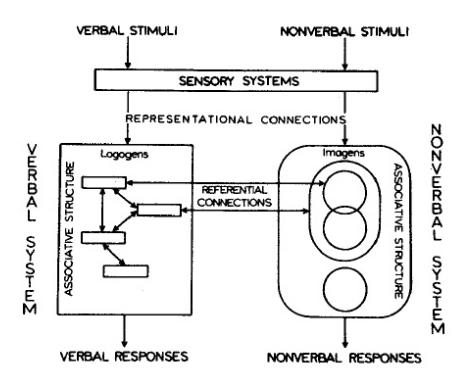This is an old revision of the document!
Dual Coding Theory
General
Dual coding is a theory of cognition introduced by Allan Pavio in late 1960s. This theory suggests two distinct subsystems contributing to cognition: one is specialized for language and verbal information, and the other for images and non-verbal information.
What is dual coding theory?

“
The most general assumption in dual coding theory is that there are two classes of phenomena handled cognitively by separate subsystems, one specialized for the representation and processing of information concerning nonverbal objects and events, the other specialized for dealing with language.”
1)
These two kinds of processing systems result in two types of stored representations:
logogens, referring to verbal entities, and
imagens, referring to mental images and non-verbal entities.
Logogens and imagens are connected with two kinds of relations:
Referential connections, which represent links between logogens and imagens. Referential connections enable performing operations like imaging to words and namings to pictures or images to words. For example, associations of an image of a school building or an unpleasant feeling (both non-verbal entities) elicited by the word school (a verbal entity).
Associative connections, which represent connections between logogens or between imagens. Associative connections on the other hand enable forming verbal-verbal or non-verbal-non-verbal associations. For example, the word school can elicit verbal entities blackboard, or boredom.
Both referential and associative types of connections help forming the complex networks of human memory.
What is the practical meaning of dual coding theory?
Criticisms
Keywords and most important names
Bibliography
Read more
Paivio, Allan. Imagery and verbal processes. Holt, Rinehart and Winston. New York, 1971.